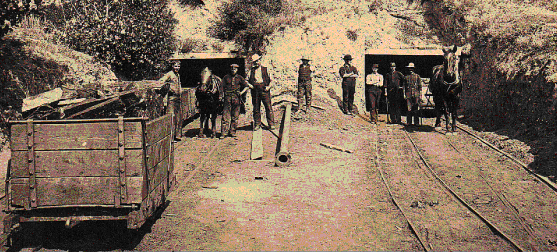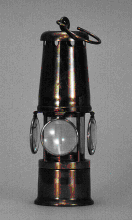
In the early days, drift mines were used to remove coal from the seams found on the valley wall. A drift mine is dug horizontally into a hillside or river valley wall by driving an adit, or opening, slightly upward into the coal seam. Usually two adits were dug about six meters apart. One was used to enter the mine and allowed horses to haul out coal cars on track while the other assured adequate air ventilation.

P19640059000-GM Men stand outside entrance to draft mine in Lethbridge.
The miners dug into the coal face with picks and shovels, creating various underground chambers or rooms. The rooms were supported by timbers throughout the mine because there was no hard rock to prevent the roof from collapsing. This system was known as the room and pillar method, and it was used in all Lethbridge mines, whether drift or shaft. Entries were driven straight through the section of seam to be mined while other entries were driven at right angles to the first, leaving a series of pillars to hold up the roof. Over time, the mine would become a honeycomb of rooms and pillars, bisected occasionally by long haulage tunnels.
Because of the limited air ventilation technology available the tunnels could only penetrate into the seam about 300 metres. This maximum distance was reached in Lethbridge by 1887. The last drift mine closed in 1893, and after that vertical shaft mining became the dominant method of removing coal. Mining from shafts was the same as drift mining, except that the entries into the coal seam were started from the bottom of a shaft rather than from the river bank. As the loaded colliery cars came back to the bottom of the shaft, they were pushed on to an elevator platform and carried to the top of the shaft.

P19640861000-GA Lantern from 1911 used in the Lethbridge area.
From the time of Nicholas Sheran's pick and shovel to the diesel locomotives and mechanical coal cutting machines of later decades, the coal mines in Lethbridge witnessed a spectacular evolution in coal mining technology.
Previous Page | Exhibit Contents | Home | Navigation Information | Glossary | Curriculum Guide | Next Page
Copyright © 1996 Sir Alexander Galt Museum. All rights reserved.